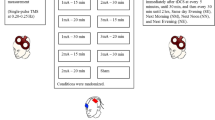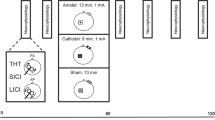Abstract
Despite holding significant promise for counteracting the deleterious effects of ageing on cognitive and motor function, little is known of the effects of facilitatory non-invasive brain stimulation (NBS) techniques on corticospinal excitability (CSE) in older adults. Thirty-three older adults (≥60 years) participated in four NBS sessions on separate days, receiving 10- and 20-min anodal transcranial direct current stimulation (atDCS), and 300 and 600 pulses of intermittent theta burst stimulation (iTBS) over the left M1. Motor-evoked potentials measured in the contralateral hand served as a measure of CSE before and for 30 min following each NBS intervention. At the group level, generalized post-stimulation CSE increases were observed (p < 0.001) with no significant differences between the two durations of each stimulation type (atDCS: p = 0.5; iTBS: p = 0.9). For individuals exhibiting overall facilitatory change to atDCS (‘responders’, n = 10), 20-min atDCS resulted in longer lasting CSE facilitation than 10 min. No such difference was observed between the two iTBS protocols. Considerable variability was observed inter-individually, where 52–58 % of the cohort exhibited the expected facilitation after each of the NBS protocols—as well as intra-individually, where 45–48 % of the cohort maintained consistent post-stimulation responses across the varying durations and types of stimulation. In conclusion, as shown previously in young adults, older adults demonstrate substantial variability in response to different facilitatory NBS protocols. Studies to assess the intra-individual reliability of these protocols are critical to progress towards translation of appropriate protocols (i.e. those that elicit the greatest response for each individual) into clinical practice.





Similar content being viewed by others
Notes
We have reported some aspects of the atDCS data that are not related to the current study elsewhere (Puri et al. 2015).
References
Bastani A, Jaberzadeh S (2012) Does anodal transcranial direct current stimulation enhance excitability of the motor cortex and motor function in healthy individuals and subjects with stroke: a systematic review and meta-analysis. Clin Neurophysiol 123:644–657. doi:10.1016/j.clinph.2011.08.029
Carroll TJ, Barry B, Riek S, Carson RG (2001) Resistance training enhances the stability of sensorimotor coordination. Proc R Soc Lond B: Biol Sci 268:221–227
Chew T, Ho KA, Loo CK (2015) Inter- and intra-individual variability in response to transcranial direct current stimulation (tDCS) at varying current intensities. Brain Stimul 8:1130–1137. doi:10.1016/j.brs.2015.07.031
Chung SW, Hill AT, Rogasch NC, Hoy KE, Fitzgerald PB (2016) Use of theta-burst stimulation in changing excitability of motor cortex: a systematic review and meta-analysis. Neurosci Biobehav R 63:43–64. doi:10.1016/j.neubiorev.2016.01.008
Davidson TW, Bolic M, Tremblay F (2016) Predicting modulation in corticomotor excitability and in transcallosal inhibition in response to anodal transcranial direct current stimulation. Front Hum Neurosci. doi:10.3389/fnhum.2016.00049
Deary IJ et al (2009) Age-associated cognitive decline. Br Med Bull 92:135–152. doi:10.1093/bmb/ldp033
Di Lazzaro V et al (2008) The physiological basis of the effects of intermittent theta burst stimulation of the human motor cortex. J Physiol-Lond 586:3871–3879. doi:10.1113/jphysiol.2008.152736
Di Lazzaro V et al (2013) Transcranial direct current stimulation effects on the excitability of corticospinal axons of the human cerebral cortex. Brain Stimul 6:641–643. doi:10.1016/j.brs.2012.09.006
Dick JP, Guiloff RJ, Stewart A, Blackstock J, Bielawska C, Paul EA, Marsden CD (1984) Mini-mental state examination in neurological patients. J Neurol Neurosurg Psychiatry 47:496–499
Dickins DSE, Sale MV, Kamke MR (2015) Plasticity induced by intermittent theta burst stimulation in bilateral motor cortices is not altered in older adults. Neural Plast. doi:10.1155/2015/323409
Fathi D, Ueki Y, Mima T, Koganemaru S, Nagamine T, Tawfik A, Fukuyama H (2010) Effects of aging on the human motor cortical plasticity studied by paired associative stimulation. Clin Neurophysiol 121:90–93. doi:10.1016/j.clinph.2009.07.048
Freitas C et al (2011) Changes in cortical plasticity across the lifespan. Front Aging Neurosci 3:5. doi:10.3389/fnagi.2011.00005
Fujiyama H, Hyde J, Hinder MR, Kim SJ, McCormack GH, Vickers JC, Summers JJ (2014) Delayed plastic responses to anodal tDCS in older adults. Front Aging Neurosci 6:115. doi:10.3389/fnagi.2014.00115
Gamboa OL, Antal A, Moliadze V, Paulus W (2010) Simply longer is not better: reversal of theta burst after-effect with prolonged stimulation. Exp Brain Res 204:181–187. doi:10.1007/s00221-010-2293-4
Hamada M, Murase N, Hasan A, Balaratnam M, Rothwelll JC (2013) The role of interneuron networks in driving human motor cortical plasticity. Cereb Cortex 23:1593–1605. doi:10.1093/cercor/bhs147
Hinder MR, Schmidt MW, Garry MI, Summers JJ (2010) Unilateral contractions modulate interhemispheric inhibition most strongly and most adaptively in the homologous muscle of the contralateral limb. Exp Brain Res 205:423–433. doi:10.1007/s00221-010-2379-z
Hinder MR, Goss EL, Fujiyama H, Canty AJ, Garry MI, Rodger J, Summers JJ (2014) Inter- and intra-individual variability following intermittent theta burst stimulation: implications for rehabilitation and recovery. Brain Stimul 7:365–371. doi:10.1016/j.brs.2014.01.004
Ho KA et al (2016) the effect of transcranial direct current stimulation (tDCS) electrode size and current intensity on motor cortical excitability: evidence from single and repeated sessions. Brain Stimul 9:1–7. doi:10.1016/j.brs.2015.08.003
Horvath JC, Forte JD, Carter O (2015) Evidence that transcranial direct current stimulation (tDCS) generates little-to-no reliable neurophysiologic effect beyond MEP amplitude modulation in healthy human subjects: a systematic review. Neuropsychologia 66:213–236. doi:10.1016/j.neuropsychologia.2014.11.021
Horvath JC, Vogrin SJ, Carter O, Cook MJ, Forte JD (2016) Effects of a common transcranial direct current stimulation (tDCS) protocol on motor evoked potentials found to be highly variable within individuals over 9 testing sessions. Exp Brain Res. doi:10.1007/s00221-016-4667-8
Hsu WY, Ku Y, Zanto TP, Gazzaley A (2015) Effects of noninvasive brain stimulation on cognitive function in healthy aging and Alzheimer’s disease: a systematic review and meta-analysis. Neurobiol Aging 36:2348–2359. doi:10.1016/j.neurobiolaging.2015.04.016
Huang YZ, Edwards MJ, Rounis E, Bhatia KP, Rothwell JC (2005) Theta burst stimulation of the human motor cortex. Neuron 45:201–206. doi:10.1016/j.neuron.2004.12.033
Huang YZ, Chen RS, Rothwell JC, Wen HY (2007) The after-effect of human theta burst stimulation is NMDA receptor dependent. Clin Neurophysiol 118:1028–1032. doi:10.1016/j.clinph.2007.01.021
Krause B, Cohen Kadosh R (2014) Not all brains are created equal: the relevance of individual differences in responsiveness to transcranial electrical stimulation. Front Syst Neurosci. doi:10.3389/fnsys.2014.00025
Krause B, Marquez-Ruiz J, Cohen Kadosh R (2013) The effect of transcranial direct current stimulation: a role for cortical excitation/inhibition balance? Front Hum Neurosci 7:602. doi:10.3389/fnhum.2013.00602
Labruna L et al (2016) Efficacy of anodal transcranial direct current stimulation is related to sensitivity to transcranial magnetic stimulation. Brain Stimul 9:8–15. doi:10.1016/j.brs.2015.08.014
Lang N et al (2011) Transcranial direct current stimulation effects on I-wave activity in humans. J Neurophysiol 105:2802–2810. doi:10.1152/jn.00617.2010
Lopez-Alonso V, Cheeran B, Rio-Rodriguez D, Fernandez-del-Olmo M (2014) Inter-individual variability in response to non-invasive brain stimulation paradigms. Brain Stimul 7:372–380. doi:10.1016/j.brs.2014.02.004
Lopez-Alonso V, Fernandez-del-Olmo M, Costantini A, Gonzalez-Henriquez JJ, Cheeran B (2015) Intra-individual variability in the response to anodal transcranial direct current stimulation. Clin Neurophysiol 126:2342–2347. doi:10.1016/j.clinph.2015.03.022
McCambridge AB, Stinear JW, Byblow WD (2015) ‘I-wave’ Recruitment Determines Response to tDCS in the Upper Limb, but Only So Far. Brain Stimul 8:1124–1129. doi:10.1016/j.brs.2015.07.027
Monte-Silva K, Kuo MF, Hessenthaler S, Fresnoza S, Liebetanz D, Paulus W, Nitsche MA (2013) Induction of late LTP-like plasticity in the human motor cortex by repeated non-invasive brain stimulation. Brain Stimul 6:424–432. doi:10.1016/j.brs.2012.04.011
Muller-Dahlhaus JF, Orekhov Y, Liu Y, Ziemann U (2008) Interindividual variability and age-dependency of motor cortical plasticity induced by paired associative stimulation. Exp Brain Res 187:467–475. doi:10.1007/s00221-008-1319-7
Nettekoven C et al (2014) Dose-dependent effects of theta burst rTMS on cortical excitability and resting-state connectivity of the human motor system. J Neurosci 34:6849–6859. doi:10.1523/Jneurosci.4993-13.2014
Nettekoven C et al (2015) Inter-individual variability in cortical excitability and motor network connectivity following multiple blocks of rTMS. Neuroimage 118:209–218. doi:10.1016/j.neuroimage.2015.06.004
Nitsche MA, Paulus W (2000) Excitability changes induced in the human motor cortex by weak transcranial direct current stimulation. J Physiol 527(Pt 3):633–639
Nitsche MA et al (2003) Pharmacological modulation of cortical excitability shifts induced by transcranial direct current stimulation in humans. J Physiol-Lond 553:293–301. doi:10.1113/jphysiol.2003.049916
Pedapati EV, Gilbert DL, Horn PS, Huddleston DA, Laue CS, Shahana N, Wu SW (2015) Effect of 30 Hz theta burst transcranial magnetic stimulation on the primary motor cortex in children and adolescents. Front Hum Neurosci. doi:10.3389/fnhum.2015.00091
Puri R, Hinder MR, Fujiyama H, Gomez R, Carson RG, Summers JJ (2015) Duration-dependent effects of the BDNF Val66Met polymorphism on anodal tDCS induced motor cortex plasticity in older adults: a group and individual perspective. Front Aging Neurosci 7:107. doi:10.3389/fnagi.2015.00107
Reuben DB et al (2013) Motor assessment using the NIH Toolbox. Neurology 80:S65–S75. doi:10.1212/WNL.0b013e3182872e01
Sale MV, Ridding MC, Nordstrom MA (2008) Cortisol inhibits neuroplasticity induction in human motor cortex. J Neurosci 28:8285–8293. doi:10.1523/Jneurosci.1963-08.2008
Seidler RD et al (2010) Motor control and aging: links to age-related brain structural, functional, and biochemical effects. Neurosci Biobehav Rev 34:721–733. doi:10.1016/j.neubiorev.2009.10.005
Sink C, Stroh H (2006) Practical significance: the use of effect sizes in school counseling research. Prof Sch Couns 9:401–411. doi:10.5330/prsc.9.4.283746k664204023
Strube W, Bunse T, Malchow B, Hasan A (2015) Efficacy and interindividual variability in motor-cortex plasticity following anodal tdcs and paired-associative stimulation. Neural Plast. doi:10.1155/2015/530423
Summers JJ, Kang N, Cauraugh JH (2016) Does transcranial direct current stimulation enhance cognitive and motor functions in the ageing brain? A systematic review and meta-analysis. Ageing Res Rev 25:42–54. doi:10.1016/j.arr.2015.11.004
United Nations, Department of Economic and Social Affairs, Population Division (2015) World Population Ageing 2015 (ST/ESA/SER.A/390)
Vallence AM, Kurylowicz L, Ridding MC (2013) A comparison of neuroplastic responses to non-invasive brain stimulation protocols and motor learning in healthy adults. Neurosci Lett 549:151–156. doi:10.1016/j.neulet.2013.05.064
Wiethoff S, Hamada M, Rothwell JC (2014) Variability in response to transcranial direct current stimulation of the motor cortex. Brain Stimul 7:468–475. doi:10.1016/j.brs.2014.02.003
Wischnewski M, Schutter DJ (2015) Efficacy and time course of theta burst stimulation in healthy humans. Brain Stimul 8:685–692. doi:10.1016/j.brs.2015.03.004
Young-Bernier M, Tanguay AN, Davidson PSR, Tremblay F (2014) Short-latency afferent inhibition is a poor predictor of individual susceptibility to rTMS-induced plasticity in the motor cortex of young and older adults. Front Aging Neurosci. doi:10.3389/fnagi.2014.00182
Acknowledgments
The research was supported by a National Health and Medical Research Council Project Grant (APP1050261; JJS, AJC, and MRH) and an Australian Research Council Discovery Project (DP130104317; JJS and MRH). The authors would like to thank Emily L. Goss for assistance with data collection and Michael I. Garry for helpful conversations regarding data analyses. Lastly, the authors would like to sincerely acknowledge all participants for volunteering their valuable time.
Author information
Authors and Affiliations
Corresponding author
Rights and permissions
About this article
Cite this article
Puri, R., Hinder, M.R., Canty, A.J. et al. Facilitatory non-invasive brain stimulation in older adults: the effect of stimulation type and duration on the induction of motor cortex plasticity. Exp Brain Res 234, 3411–3423 (2016). https://doi.org/10.1007/s00221-016-4740-3
Received:
Accepted:
Published:
Issue Date:
DOI: https://doi.org/10.1007/s00221-016-4740-3




